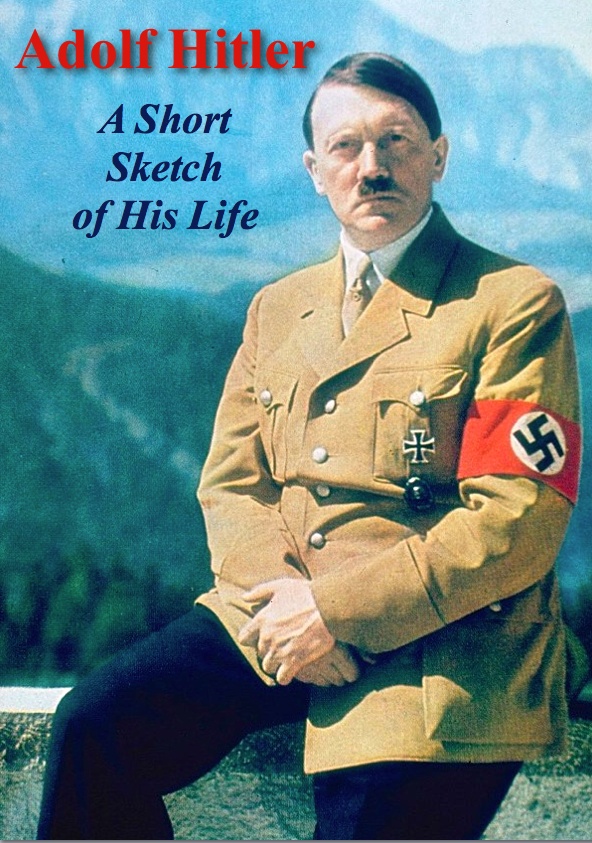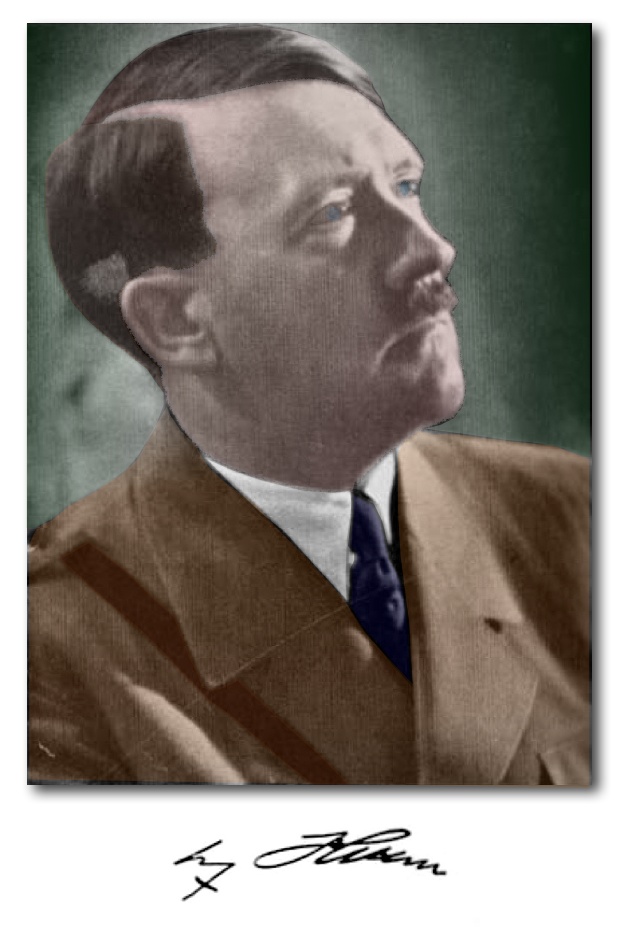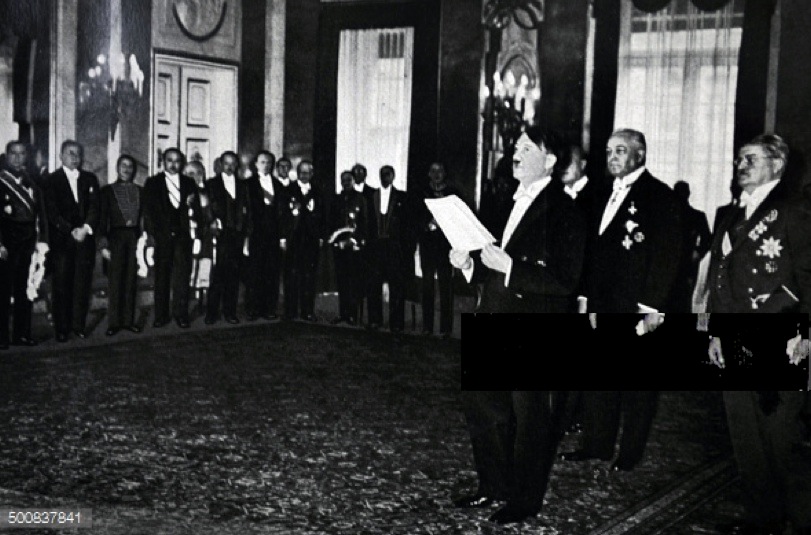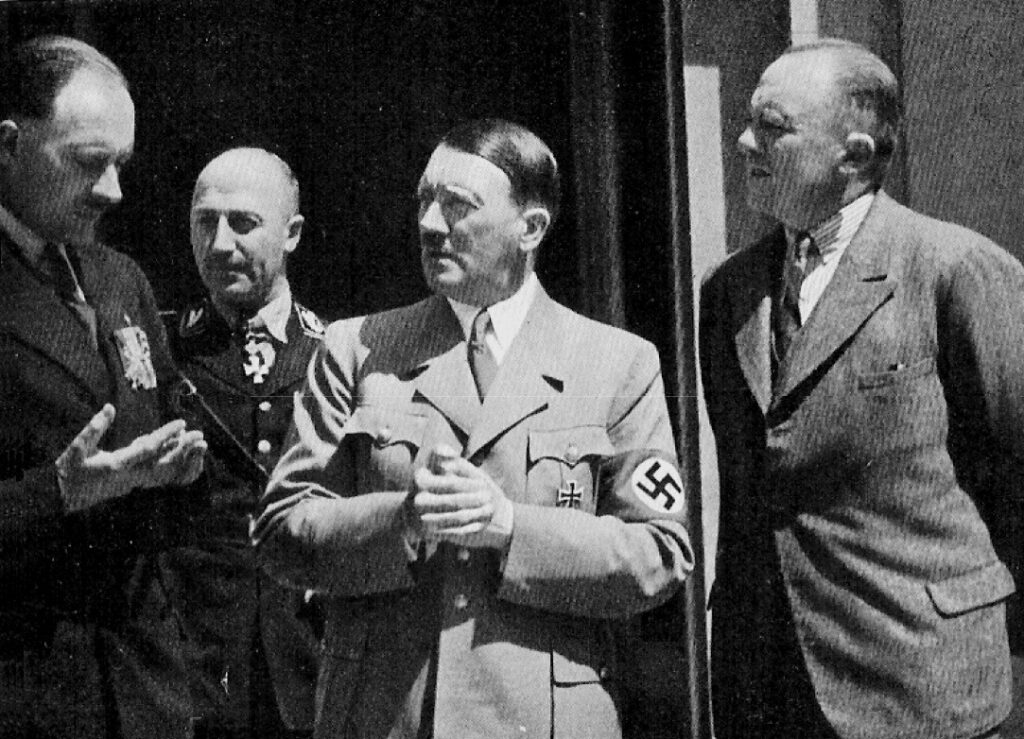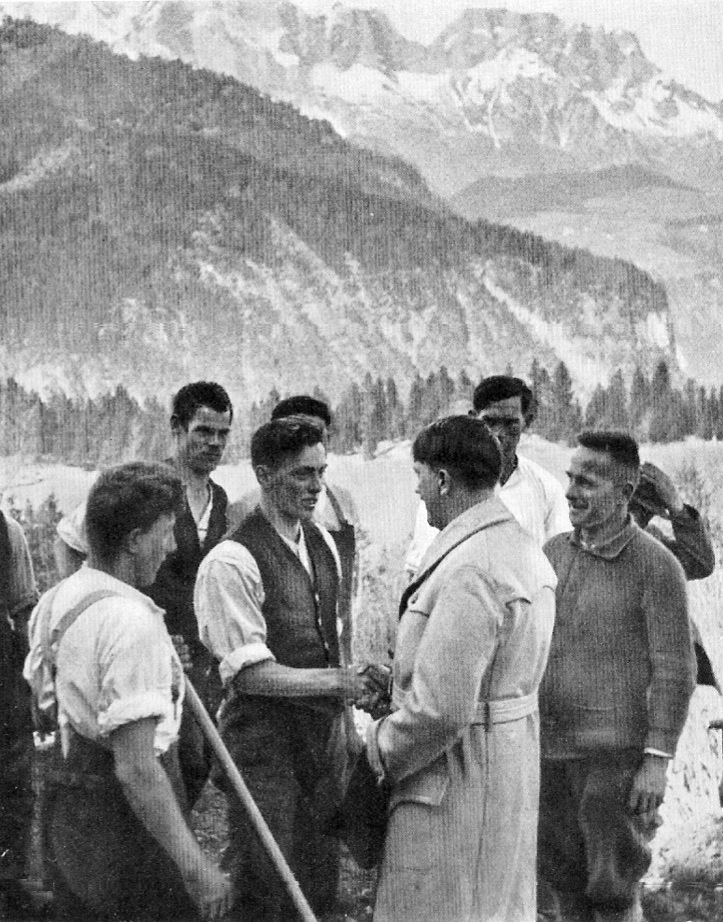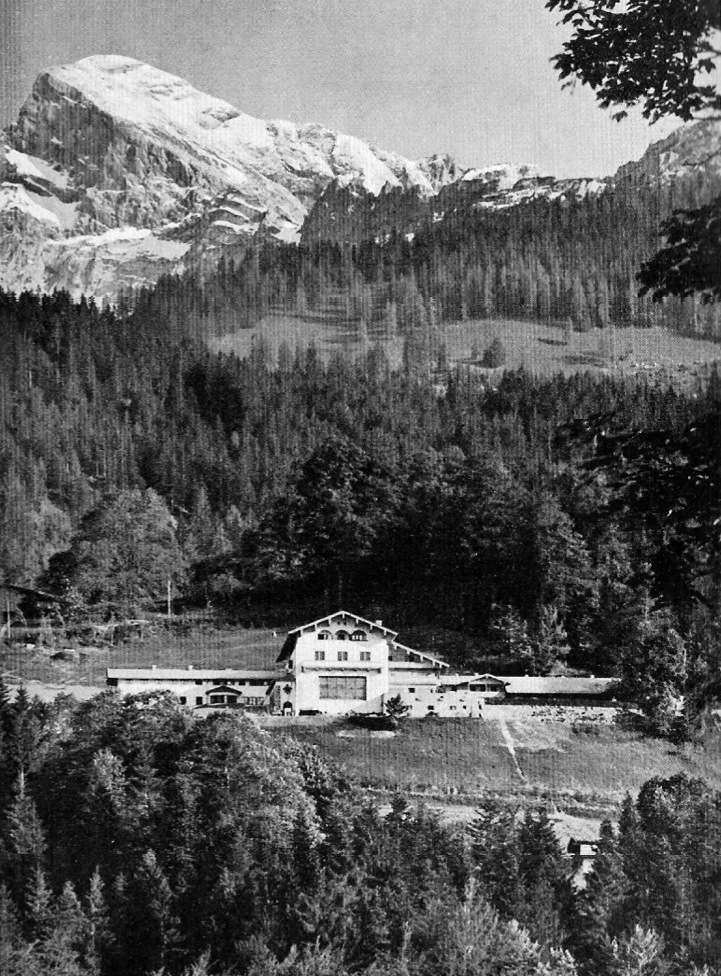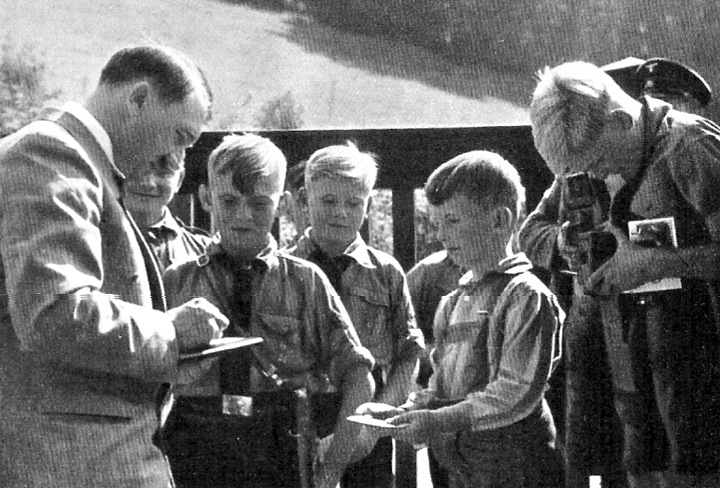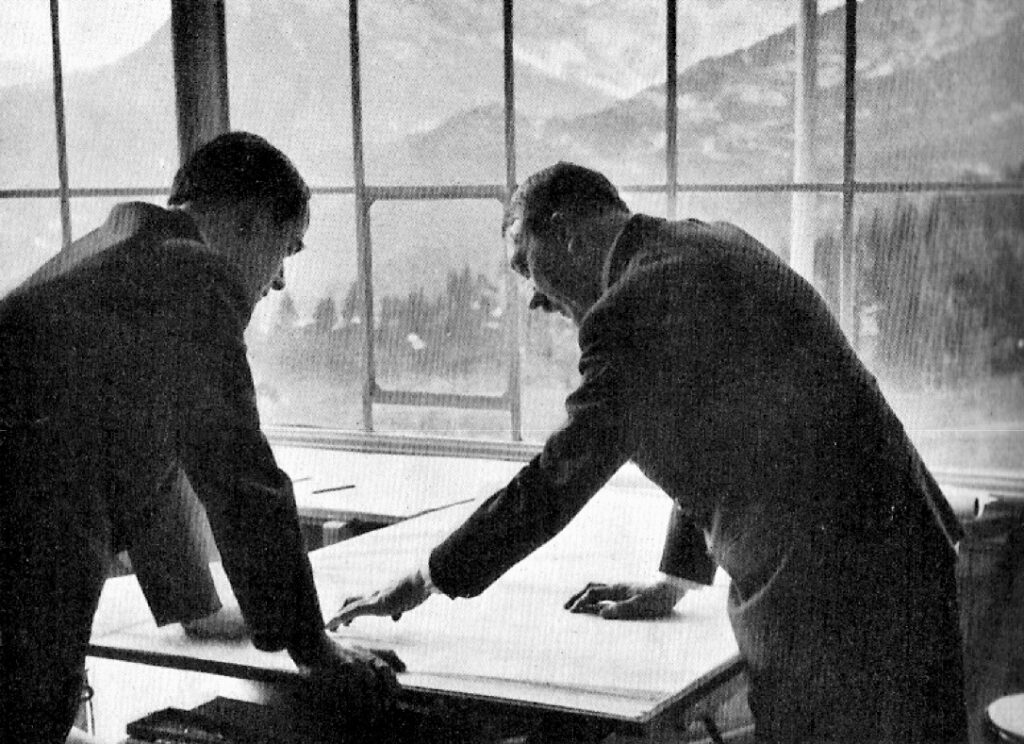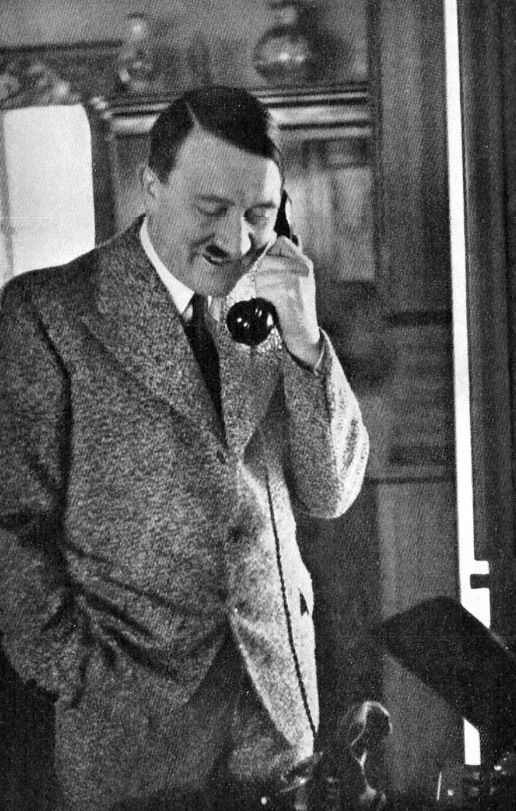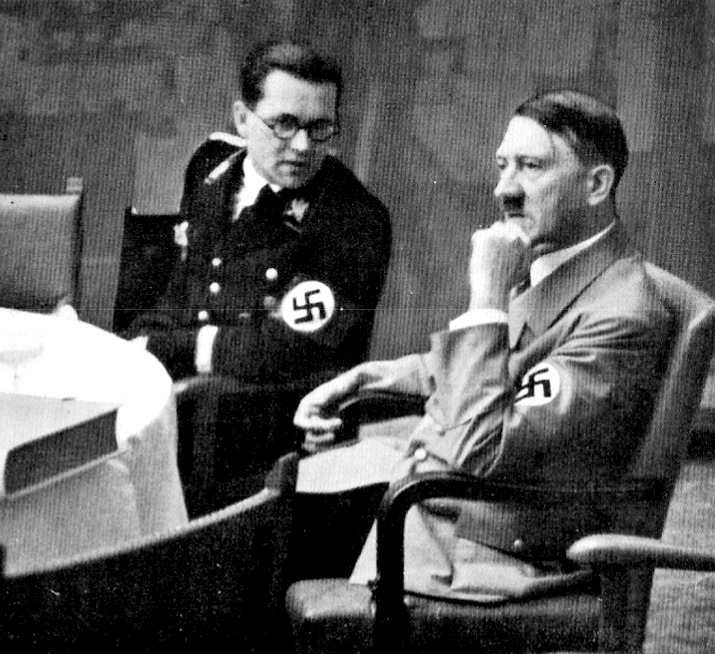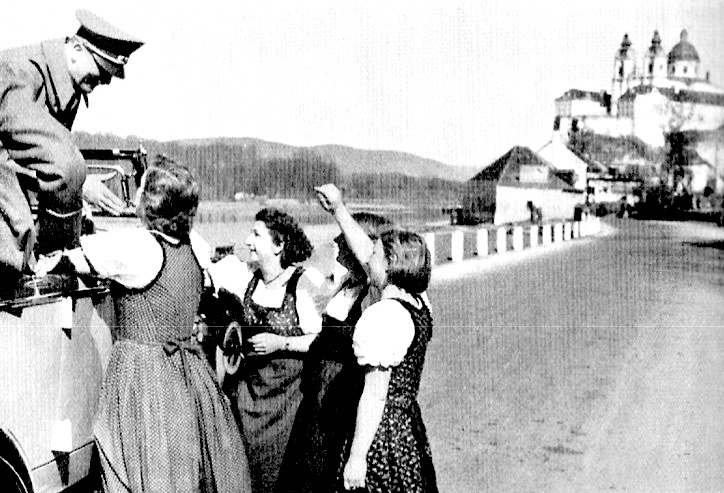[This short, easy to read, outline biography of Adolf Hitler and the creation and rise of National Socialism is a must read for all concerned with not only understanding that era but also for understanding what’s happening today.
— KATANA]
Adolf Hitler
A Short Sketch of His Life
PART 2
TERRAMARE PUBLICATIONS
Edited by Richard Monnig
No. 1
Adolf Hitler
A Short Sketch of His Life
By Philipp Bouhler
Published by Terramare Office, Berlin
[Image] Adolf Hitler and his signature.
Adolf Hitler
A Short Sketch of His Life
By Philipp Bouhler
Head of the Fuehrer’s Personal Chancellery
1938
TERRAMARE OFFICE, BERLIN W8
CONTENTS
INTRODUCTION
GENESIS OF THE MOVEMENT
THE COUP D’ETAT
CRITICAL DAYS
THE MOVEMENT ADVANCES
FROM VICTORY TO VICTORY
HITLER IN POWER
THE THIRD REICH
THE MOVEMENT ADVANCES
Meanwhile Hitler promulgated his ideas among the masses, always accompanied by his loyal private secretary and political adjutant, Rudolf Hess, who had also shared his company in the fortress, he held meetings in Thuringia, Wurttemberg, Mecklenburg and Brunswick — the federative states in which he still enjoyed the right of public speech. Hand in hand with this work of propaganda went the process of building up the organization. In several districts of North Germany the foundation for the establishment of sub-branches was first laid. A constantly growing staff of speakers went hither and thither throughout Germany, preaching Hitler’s doctrines and bringing them home to the minds and hearts of the people.
But still the Movement continued to be strongest in Bavaria, though in Saxony also it showed a rapid development. At the end of 1926 Dr. Josef Goebbels was appointed Gauleiter of Greater Berlin. With that the struggle in the Capital of the Reich showed an important stage in its advance.
[Page 26]
[Image] “National Socialist Germany wants peace because of its fundamental convictions. And it wants also owing to the realisation of the simple primitive fact that no war would be likely essential to alter the distress in Europe.”
Hitler, May 21, 1935.
Besides the S.A., the S.S. (Schutz Staffel — Defence Squadron) was now formed of men who had been specially selected, They wear black uniforms and are entrusted with the task of protecting the movement as well as with propaganda work and other special duties. Since 1928 this body of men has been under the control of its Reich Leader, Heinrich Himmler.
The Movement founded a Youth Organization known as the Hitler Youth, which spread rapidly especially among the children of the working classes. Students soon began to crowd into the Movement and were grouped under “The National Socialist German Students’ League”, the leadership of which is today in the hands of Baldur von Schirach. In 1932 Schirach was also placed in charge of the Hitler Youth and the National Socialist School Children’s League.
Despite the manifest progress that had been made it must have seemed a daring step when Hitler summoned his followers to a Party Congress at Weimar in June, 1926. But this Congress turned out a complete success. Several thousand S.A. and S.S. men took part m the march-past and received a tumultuous reception from the general public. They wore the brown uniforms on this occasion, instead of the waterproof jackets they had worn in 1923.
To a wider sphere of outsiders it was now proved once again that the Movement was not dead but very much alive and steadily growing. And the Party members who attended this Congress gained new strength and new faith for the coming struggle. They felt that the Movement had now passed through its most difficult period and that the danger of stagnation was over. At the end of 1925 the number of members had reached 27,117. By December 1926 it had increased to 49,523, by December 1927 to 72,590, by December 1928 to 108,717. In December 1929 the Party had a membership of 176,426.
[Page 28]
[Image] “I started the National Socialist Revolution by bringing the movement into being, and since then I have directed the revolution into the path of action. I know that none of us will live to see more than the very beginning of this great revolutionary development. What then could I wish more than peace and tranquility?”
Hitler, May 21, 1933
[Page 29]
In 1927 the right of public speech was restored to Hitler in Bavaria. Prussia restored it in 1928. The federative government and the parties supporting them found it no longer possible maintain a policy which denied the right of public speech. Moreover they had to recognize the fact that this policy of throttling the Movement, assisted by acts of terror on the part of the Marxists did not hinder the movement but rather hastened its development.
With the election of von Hindenburg on April 26, 1925 as President of the Reich, certain people thought that this would bring a change in the method of government and put an end to the stupid policy which favoured a Francophile understanding. But these people were bitterly disillusioned. While the governments sought by every means to prevent any movement of national revival from raising its head in Germany their own feckless attitude towards ail decisions in foreign politics was encouraged and all those factors were lacking which might put some backbone into the conduct of public affairs. Despite his constantly repeated failures Stresemann saw “the silver lining on the political horizon”, while unemployment and economic distress steadily increased. The consequences of the Dawes Plan, of the year 1924, became apparent in all their bitter reality, although a little earlier that Plan was hailed as the salvation of the nation, a Plan that would reinvigorate the national economic system and therewith furnish the conditions necessary for a political resurgence. Against all this Hitler always maintained a determined stand, claiming that no economic revival would be possible until political power had been won back. His innumerable addresses to industrial and economic leaders succeeded in spreading his ideas more and more widely among those circles. There was a constantly growing number of people who believed Hitler’s movement was not only the well-spring from which the national idea was being revived but that it was also the sole means of saving the nation from economic collapse. The National Socialist Party Congresses at Nuernberg in 1927 and 1929 gave striking proof of the development of the organization and the growing influence which Hitler was exercising among the people of Germany.
[Page 30]
[Image] New Year Reception of Foreign Ambassadors.
On the occasion of the Party Congress in 1929 well over 100,000 persons made a pilgrimage to the old imperial city. Twenty-four new standards were presented to the S.A. following a solemn commemoration service for the dead at the War Monument in the Luitpoldhain. The march-past of the S.A. at the close of the ceremony, when Hitler took the salute, lasted close on four hours and formed an imposing demonstration.
In the realm of higher politics Hitler was now no longer looked upon merely as a beater of the big drum, but an all round respect began to be shown for his statesmanlike qualities. His “Open Answer to Herve’”, in which he replied to the French politician and stated his own opinions on disarmament and on how relations between France and Germany should best be established, brought Hitler before the eyes of the public also in foreign countries. The fight against the Young Plan led to the plebiscite of 1929, though the 6 1/2 million votes registered on that occasion were not sufficient to prevent the Plan from being carried through. From that time onwards Hitler was accepted as the leading person who represented in the most energetic fashion the fight against the policy of German enslavement.
[Page 31]
FROM VICTORY TO VICTORY
On their first appearance, as a Party at the General Election of May 20, 1928 the National Socialists secured 810,000 votes and sent 12 deputies to the Reichstag. On September 14, 1930, the number of votes which they received increased to 6,400,000. The Brown Shirt deputies now numbered 107, which made them the second strongest group in the Reichstag. Only the Social Democrats were numerically stronger, having 154 deputies.
It was now out of the question for anybody not to take the National Socialists seriously. On the one hand this fact became evident by the rapid increase in membership and, on the other hand, it was demonstrated by the extraordinary bitter opposition now put up by all sides against the Movement.
The number of registered members of the Party at the end of 1930 totalled 389,000. In December 1931 this had increased to 806,294. On May 31,1932, it was 1,118,270 and on March 1,1933 1,471,114. On the other hand the Marxist system of terrorization increased at such an enormous rate that one was right in speaking of a civil war instigated by the Reds. Up to the time that National Socialism took over supreme political power 206 members had been murdered and 25,000 wounded in attacks on them by their opponents. These martyrs furnished incontestable proof of the faith and spirit of sacrifice given to the service of the National Socialist teaching and its Fuehrer.
As the President’s regular period of office was nearing its end, a step was taken which brought Hitler into the foreground in negotiations with certain persons in the Reich Government Chancellor Bruening endeavoured to get Hitler to consent the passing of a special measure in the Reichstag for the purpose of prolonging Hindenburg’s term of office as President. But the Bruening attempt failed.
[Page 32]
[Image] Hitler speaks with a Delegation of British Ex-Service Men.
Therefore a new election became unavoidable. On February 26, 1932, Hitler was made a member of the civil service, with the rank of counsellor (Regierungsrat) in the federative state of Brunswick, by the Government of that state. This act conferred on him, ipso facto, the rights of German Citizenship; so that he now became eligible as candidate for the Presidency of the Reich.
Thus a sorry chapter was closed in the story of German political party bureaucracy. Hitler had been born of German parents on the German frontier. He had fought through the war in the ranks of the German Army. His life had been one long struggle on Germany’s behalf. And yet the right of German citizenship was withheld from him up to now.
[Page 33]
Hitler took part in the presidential election of March 13, 1932 as a candidate against von Hindenburg. He received 11.3 million votes, whereas Hindenburg received 18.6 million. The result was by no means a defeat for Hitler but rather a significant success. For this result practically showed that during the previous eighteen months — since the last Reichstag election — the number of votes cast for him had nearly doubled.
The regime now used all possible means to hinder the National Socialist propaganda, which was already seriously handicapped by a one-sided control of the national broadcasting system. By proclaiming the “Easter Truce” the preparatory period for the second election was restricted to six days. But Hitler launched what may be called a propaganda campaign of gigantic proportions such as had never been experienced before. At the second election, on April 10, he not only retained his votes but increased them by 2.1 million, to 13.4 million. This tremendous success was mainly due to the wholehearted way in which Hitler threw himself into the fight.
Although Hindenburg was finally elected, the Reich Government had not counted on Hitler being able to obtain the large number of votes he actually obtained. They then took a desperate step. On April 13 the Government issued an emergency Order immediately dissolving the S.A. and the S.S., the Hitler Youth, the National Socialist Motor Corps and the Flying Corps.
The measure prohibiting the S.A. was a failure. It brought about the downfall of Greener, the Reich Minister of the Interior, who resigned from the Cabinet. Bruening’s own resignation from the Chancellorship, together with that of the rest of his Cabinet, followed. Von Papen now formed a Cabinet and declared a new General Election for July 31.
In his third electoral campaign, in which he used an aeroplane for purposes of rapid travel, Hitler was the central figure of the battle and went through the length and breadth of the country as a triumphant hero. Within a fortnight he spoke at 49 mass meetings. The electorate gave 13,700,000 votes for the National Socialist candidates, with the result that the latter now acquired 230 seats in the Reichstag. Thus the appeal which the Government had made to the country turned out a failure.
[Page 34]
[Image] A hearty handshake with the workmen.
But the Government of the Reich did not act on the logical consequences of this expression of the popular will. They still attempted to exclude what was now by far the largest political party from the responsible government of the country. The derogatory offer of a Vice-Chancellorship received a direct negative reply from Hitler. He had not organized and developed his movement for the purpose of lending his name to the emergency decrees of a reactionary government.
When Hitler received the news of the Beuthner verdict, whereby five Silesian S.A. men were sentenced to death, he issued a stirring appeal on behalf of his comrades. He scoffed at the boasted impartiality of a Government which could make no distinction between men who represented the national spirit of the people and a canaille of scoundrels who were traitors to the country. He now announced that he would fight to the very bitter end to save the lives of these five men.
HITLER IN POWER
A fresh election was held on November 6. This time the result showed a reduction from 13,400,000 to 11,800,000 of the votes cast in his favour. There was a corresponding reduction in the number of National Socialist deputies, from 230 to 196. Hitler’s opponents were jubilant over the result. Hitler obstinately refused to be satisfied with the Vice-Chancellorship and the Government adopted a dictatorial attitude on the other side. The situation which thus resulted created among many people the impression that Hitler had missed his opportunity and that his movement was weakening. But the jubilant cries of his opponents were short-lived. Hitler had the courage and firmness of mind to wait. At the end of January, 1933, the then Chancellor, General Schleicher, stood completely isolated.
On January 28 his entire Cabinet resigned and on January 30, President of the Reich entrusted Hitler with the task of forming a new Cabinet.
[Page 36]
[Image] The Berghof. Hitler’s house on the Obersalzberg.
[Page 37]
The formation of a new Reich Government and the abolition of the dualism between the Reich and Prussia created for the first time a basis for conducting politics on unified national lines in Germany, as well as the possibility of exterminating all elements of an anti-national character. Therewith the National Socialist Movement entered upon the second phase of its gigantic struggle; that is to say, responsible and constructive statesmanship after twelve years of opposition. In an address to the German people the Chancellor appealed for national discipline and asked that the National Government be granted four years in which to build up the new Reich from the ruins of fourteen years of irresponsible government and also be given authority to deal with the unemployment question and the urgent problem of saving the farming classes from total ruin.
The assumption of power at last enabled Hitler to throw off those shackles which had hitherto fettered his endeavours. He was now able to address the outlying districts through the radio. The speeches he held at gigantic mass meetings and broadcast to the whole nation expressed his determined intention to restore German liberty and received an enthusiastic response from the public. This wave of enthusiasm reached its height on the eve of the new Reichstag election — the Day of National Awakening — when the Chancellor spoke from East Prussia to the whole nation. The announcement of the firm will to victory, the determination to restore German freedom and the appeal for loyalty to the fatherland raised new hopes in the hearts of millions of Germans at home and abroad. Church bells pealed joyously. Liberty bonfires burned on the hilltops. The streets in the towns and villages were gaily decorated with flags.
The magnitude of the victory won on March 5 was unparalleled in German history. And it was as unexpected as it was unparalleled. 17,300,000 people cast their votes for Hitler whose name headed the list of candidates in every district throughout the country.
[Page 38]
[Image] Some young Autograph Hunters.
288 Reichstag seats were won by the National Socialist Party and this gave the Government a 52% majority in parliament. Although if the result had been different the Government were determined to follow the one and only road which would lead to the restoration of German liberty; yet the actual result made it possible to carry out the new policy on a strictly parliamentary basis. Marxism and its supporters had received a severe blow. The Communists lost twenty seats and the Centre Party was deprived of its key position.
[Page 39]
THE THIRD REICH
The heritage which Adolf Hitler took over on January 30, 1933, has been picturesquely described as a heap of ruins. Fourteen years of party strife and mismanagement of national affairs had reduced the once great and proud German nation to a state of chaos. In relation to the outside world it was a nation without arms and without rights, respected by no one and oppressed under a series of humiliating treaties which could not possibly be fulfilled. It was a nation that had sunk to the level of a vassal to foreign states, Marxist usurpers had bartered away the honour and property of the Reich. The economic structure had totally collapsed and Germany was now bleeding herself to death in an effort to make reparation payments.
Party strife and class-hatred ran riot. The separatist movement became acute and threatened the dismemberment of Germany. The Governments of the federative states appropriated ruling functions to such a degree as to impair seriously the authority of the Reich. In the Reichstag the representatives of the innumerable parties frittered away time and energy with interminable controversies and bartering for ministerial posts. Meanwhile one industrial factory after another had to close down. Concern after concern went into bankruptcy. Farmers had to forfeit their cattle and crops because they were unable to pay the arrears of taxes and interests on mortgages. The ominous spectre of seven million unemployed stalked the roads and streets. The criminal class increased at an alarming rate.
The number of votes cast for the Communist Party increased to a portentious degree from one general election to another. Indeed it seemed only a question of months before Bolshevism would set up Its rule of terror in Germany, unless the National Socialists succeeded in taking over supreme control of the State. When they did succeed however and when at the last moment the venerable President of the Reich entrusted Hitler with the formation of a new Government — after all the other cabinets had failed — the most decisive turning point in German history had been taken.
On March 23, 1933, the Fuehrer asked for four years in which he could put into practice his measures for the restoration of the German nation. The law which gave him unlimited powers for this purpose was constitutionally passed by Parliament,
[Page 40]
[Image] In Hitler’s studio at Obersalzberg.
After the expiry of this period, when he had given a public account of what had been done and called for a plebiscite, the nation applauded his efforts unanimously and sanctioned his stewardship by giving 99% of the total electoral vote in his favour. No democracy throughout the world or through the course of history has ever given a statesman a similar vote of confidence. This overwhelming unanimity in giving judgement on the policy of the Fuehrer was the deserved fruit of the tireless and successful efforts which he had made on behalf of the country and the people. Here, if ever, the voice of the people could indeed be called the voice of God.
One of the first measures which the Fuehrer enacted was that which established legislative and administrative unity throughout the Reich, replacing the governments of the various federative states and their legislatures by a strong central Government in Berlin. At the same time parliamentary parties were dissolved and the National Socialist Party remained the sole trustee of the political will of the people.
[Page 41]
For the first time in German history the division between political interests and government interests was abolished. The problem of unemployment was then tackled in a vigorous manner. As a result of large- scale measures, trade and industry were revived and thrived so well that today there is no longer any unemployment in Germany. The Fuehrer enacted laws against racial degeneration which definitively prevent the further propagation of the unfit and mentally deficient or unhealthy, who were costing the country 200,000,000 marks annually for support and attendance. A law was also passed to prevent the further mongrelizing of the German people through intermixture with the Jews, who are of a totally different racial stock.
A further series of laws, especially those laying down price regulations for agricultural products and the law establishing hereditary farms, improved the position of the agricultural classes and prepared the way for more prosperous times. Trade-unions, with their class-war and policy of class-hatred, were dissolved and replaced by the German Labour Front, an organization which embraces every worker in Germany under the aegis of the ideal of work as a factor that raises the dignity of human nature rather than lowers it.
The National Socialist Welfare Organization, already founded by the National Socialist Party before it had acquired supreme political power, has been greatly enlarged. In conjunction with the Winter Help, it has become an eloquent expression of the spirit of ready sacrifice which inspires the whole nation in dealing with problems relating to the poor and those who need help of one kind or another.
The organization of the youth, the Reich Labour Service and “Strength through Joy” are now standing institutions which have been “established in response to the creative will of the Fuehrer.”
[Page 42]
[Image] Adolf Hitler on the phone.
[Page 43]
A cultural policy has been adopted whereby a cleansing process has not only abolished every distorted and degenerative kind of Bolshevik art but has at the same time brought about a revival of genuine German art and fostered its development in every direction. German artists have again come into their rightful place. The Fuehrer, himself an enthusiast for architecture, has not only planned various gigantic building projects but has also largely designed and supervised their erection personally.
Those acquainted with the intentions which Adolf Hitler had in mind knew that he would not rest content with merely restoring order in the German domestic situation. He regarded it as one of his paramount tasks to re-establish German prestige abroad.
Having personally experienced to the full the horrors of modern warfare, he has lost no opportunity of emphasizing his absolute love for peace and his desire for an understanding with Germany’s former enemies. But at the same time he has come forward as the unflinching champion of German honour and freedom. For Adolf Hitler therefore there could be no question of rest or contentment until the shackles of dishonourable treaties were shattered and until Germany once again resumed her rightful position of equality among the nations, supported by a powerful army; not only that but also as a strong factor in maintaining peace and in readiness to defend European culture against the destructive forces of Bolshevism.
When we consider the changes which have taken place in Germany since January 30, 1933, and review the problems that are still being resolutely attacked and solved for the benefit of the whole country, it is no exaggeration to say that we are confronted with a veritable miracle, which is the product of a great and indestructible faith. For it is this faith in Germany’s future which has inspired the soul of Adolf Hitler — the unknown soldier of the Great War — and it is this same faith which has given life and shape and purpose to the National Socialist Party. An unknown individual founded a party and from this small band of men, enduring many trials and tribulations, there sprang a people’s movement and finally a new German Reich,
[Page 44]
[Image] Adolf Hitler and Philipp Bouhler, the author of this biography.
To understand all this one must understand and appreciate the character and personality of Adolf Hitler himself. Broadminded and big-hearted and just, capable of bringing iron logic to the support of his arguments, judicious and courageous in making decisions, and yet at the same time always prepared to share “the sorrows and joys which fall to the lot of his co-workers” — these are the qualities that link men inseparably to him.
He has the magnetic appeal of the genuine orator and has the power of making his audience feel that he is voicing their thought and speaking for them. That probably is because he himself has come from the people and is able to think and feel with them. And it is for this reason that the German youth has gathered so enthusiastically around him. In his personal requirements Hitler is extremely modest. He does not eat meat or take any alcoholic drinks; nor does he smoke. This is simply because he feels it suits his health better to be abstemious in regard to these things.
[Page 45]
[Image] Hitler on his way to Vienna, March 12, 1938.
His movement has restored the nation to its old position of honour. Because of this achievement and because he himself has the qualities of the born leader, he has become the idol of the whole nation. They thank him for their national renaissance, the restoration of their honour and their prestige, for their freedom and their bread. And so they have willingly placed their future in his hands, trusting unconditionally to the wisdom of his leadership.
_______________________________________
Version History & Notes
Version 1: Published Jun 25, 2015
__________________
Notes
* Contents page is not in the original.
* Cover page is not in the original.
__________________
Knowledge is Power in Our Struggle for Racial Survival
(Information that should be shared with as many of our people as possible — do your part to counter Jewish control of the mainstream media — pass it on and spread the word) … Val Koinen at
======================================
Go to: Adolf Hitler — A Short Sketch of His Life : Part 1
PDF of post. Click to view or download (4.0 MB).
Adolf Hitler – A Short Sketch of His Life – Part 2
PDF of complete booklet. Click to view or download (6.2 MB).
Adolf Hitler – A Short Sketch of His Life
Version History
Version 3: Apr 20, 2023 — Re-uploaded images and PDFs. Improved formatting.
Version 2: Nov 22, 2015 — Improved formatting.
Version 1: Published Jun 25, 2015.

